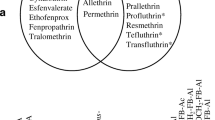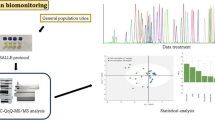Abstract
Synthetic pyrethroids are highly effective, widespread insecticides applied worldwide for different purposes. Among the possible sources of exposure for the general population, pyrethroid residues in food and their prominent use for the conservation of wool carpets or in indoor pest control might play a major role. On the basis of previous works, we have developed and validated a highly sensitive and specific GC/MS/MS-method to simultaneously quantify the metabolites of the most common synthetic pyrethroids in urine, namely cis- and trans-(2,2-dichlorovinyl)-2,2-dimethylcyclopropanecarboxylic acid (DCCA), cis-(2,2-dibromovinyl)-2,2-dimethylcyclopropanecarboxylic acid (DBCA), 4-fluoro-3-phenoxybenzoic acid (F-PBA), 3-phenoxybenzoic acid (3-PBA) as well as the metabolites cis-3-(2-chloro-3,3,3-trifluoroprop-1-enyl)-2,2-dimethyl-cyclopropanecarboxylic acid (ClF3CA, λ-cyhalothrin/bifenthrin), 4-chloro-α-isopropylbenzene acetic acid (CPBA, esfenvalerate), and 2-methyl-3-phenylbenzoic acid (MPB, bifenthrin). After acidic hydrolysis to cleave conjugates in urine, the analytes are subjected to a pH-controlled extraction into n-hexane. After concentration, the analytes are derivatised using MTBSTFA and finally quantified by GC/MS/MS in EI-mode using d6-trans-DCCA and 13C6-3-PBA as internal standards. The limit of quantification for these metabolites was 0.01 μg/L urine. Precision within and between series was determined to range between 1.6 and 10.7 % using a native quality control sample as well as a urine sample spiked with 0.3 μg/L of the analytes. To investigate possible background excretions, we analysed spot urine samples of 38 persons of the general population in a pilot study. cis- and trans-DCCA as well as 3-PBA could be quantified in every urine sample investigated, while MPB and F-PBA could only be detected in two samples. The median levels for excretion of cis-DCCA, trans-DCCA, 3-PBA, ClF3CA, DBCA, CPBA, F-PBA and MPA were 0.08, 0.17, 0.22, 0.04, 0.04, <0.01, <0.01 and < 0.01 μg/L urine, respectively. The excretion of metabolites revealed excellent correlations between cyclopropane carboxylic acids and 3-PBA. Our method is highly suitable for human biomonitoring of exposures to synthetic pyrethroids in environmental medicine. Remarkable are the high detection rates for the metabolites ClF3CA (90 %) and CPBA (40 %), proving that their parent pyrethroids have entered the market in Germany.




Similar content being viewed by others
References
Rossbach B, Appel KE, Mross KG, Letzel S. Uptake of permethrin from impregnated clothing. Toxicol Lett. 2010;192:50–5.
Rossbach B, Niemitz A, Kegel P, Letzel S. Uptake and elimination of permethrin related to the use of permethrin treated clothing for forestry workers. Toxicol Lett. 2014;231:147–53.
U.S. EPA: pesticides – permethrin facts. Available at: http://archive.epa.gov/pesticides/reregistration/web/html/permethrin_fs.html (Accessed 3 Dec 2015)
Saillenfait AM, Ndiaye D, Sabate JP. Pyrethroids: exposure and health effects—an update. Int J Hyg Environ Health. 2015;218:281–92.
Ding G, Shi R, Gao Y, Zhang Y, Kamijima M, Sakai K, et al. Pyrethroid pesticide exposure and risk of childhood acute lymphocytic leukemia in Shanghai. Environ Sci Toxicol. 2012;46:13480–7.
Ratelle M, Cote J, Bouchard M. Toxicokinetics of permethrin biomarkers of exposure in orally exposed volunteers. Toxicol Lett. 2015;232:369–75.
Ratelle M, Cote J, Bouchard M. Time profiles and toxicokinetic parameters of key biomarkers of exposure to cypermethrin in orally exposed volunteers compared with previously available kinetic data following permethrin exposure. J Appl Toxicol. 2015;35:1586–93.
Barr DB, Olsson AO, Wong LY, Udunka S, Baker SE, Whitehead RD, et al. Urinary concentrations of metabolites of pyrethroid insecticides in the general U.S. population: National Health and Environmental Survey 1999-2002. Environ Health Perspect. 2010;118:742–48.
Becker K, Seiwert M, Angerer J, Kolossa-Gehring M, Hoppe HW, Ball M, et al. GerES IV pilot study: assessment of the exposure of German children to organophosphorous and pyrethroid pesticides. Int J Hyg Environ Health. 2006;209:221–33.
Roberts TR, Hutson DH. Metabolic pathways of agrochemicals. Part II: insecticides and fungicides. Cambridge: Royal Society of Chemistry; 1999.
Schettgen T, Koch HM, Drexler H, Angerer J. New gas chromatographic-mass spectrometric method for the determination of urinary pyrethroid metabolites in environmental medicine. J Chromatogr B Analyt Technol Biomed Life Sci. 2002;778:121–30.
Larsen K. Creatinine assay by a reaction-kinetic principle. Clin Chim Acta. 1972;41:209–17.
Schettgen T, Heudorf U, Drexler H, Angerer J. Pyrethroid exposure of the general population—is this due to diet? Toxicol Lett. 2002;134:141–5.
Wielgomas B, Piskunowicz M. Biomonitoring of pyrethroid exposure among rural and urban and populations in northern Poland. Chemosphere. 2013;93:2547–53.
Bevan R, Jones K, Cocker J, Assem FL, Levy LS. Reference ranges for key biomarkers of chemical exposure within the UK population. Int J Hyg Environ Health. 2013;216:170–5.
Le Grand R, Dulaurent S, Gaulier JM, Saint-Marcoux F, Moesch C, Lachatre G. Simultaneous determination of five synthetic pyrethroid metabolites in urine by liquid chromatography-tandem mass spectrometry: application to 39 persons without known exposure to pyrethroids. Toxicol Lett. 2012;210:248–53.
McKelvey W, Jacobson JB, Kass D, Barr DB, Davis M, Calafat AM, et al. Population-based biomonitoring of exposure to organophosphate and pyrethroid pesticides in New York City. Environ Health Perspect. 2013;121:1349–56.
Bundesamt für Verbraucherschutz und Lebensmittelsicherheit. Available at: http://www.bvl.bund.de/DE/04_Pflanzenschutzmittel/05_Fachmeldungen/2010/2010_06_14_Fa_widerruf_005919_5599.html (Accessed 3 Dec 2015)
Davis MD, Wade EL, Restrepo PR, Roman-Esteva W, Bravo R, Kuklenyik P, et al. Semi-automated solid phase extraction method for the mass spectrometric quantification of 12 specific metabolites of organophosphorus pesticides, synthetic pyrethroids, and select herbicides in human urine. J Chromatogr B Analyt Technol Biomed Life Sci. 2013;929:18–26.
Manini P, Andreoli R, Mutti A. Application of liquid chromatography-mass spectrometry to biomonitoring of exposure to industrial chemicals. Toxicol Lett. 2006;162:202–10.
Author information
Authors and Affiliations
Corresponding author
Ethics declarations
Conflict of interest
The authors have no conflict of interest to declare.
Human and animal rights and informed consent
All studies involving human participants were in accordance with the ethical standards of the institutional research committee and with the 1964 Helsinki declaration, its later amendments or comparable ethical standards, and written informed consent was obtained.
Electronic supplementary material
Below is the link to the electronic supplementary material.
ESM 1
(PDF 2107 kb)
Rights and permissions
About this article
Cite this article
Schettgen, T., Dewes, P. & Kraus, T. A method for the simultaneous quantification of eight metabolites of synthetic pyrethroids in urine of the general population using gas chromatography-tandem mass spectrometry. Anal Bioanal Chem 408, 5467–5478 (2016). https://doi.org/10.1007/s00216-016-9645-2
Received:
Revised:
Accepted:
Published:
Issue Date:
DOI: https://doi.org/10.1007/s00216-016-9645-2




